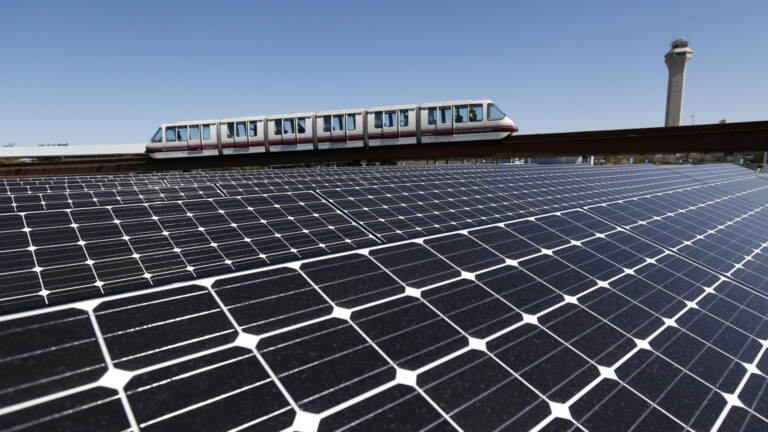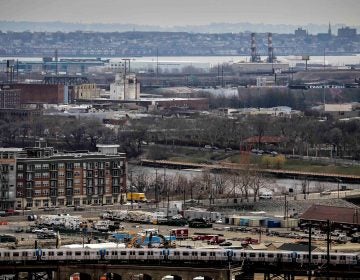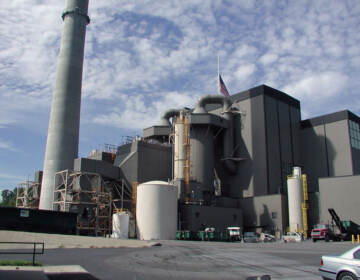After years of debate, New Jersey agrees to new solar incentives
New Jersey Board of Public Utilities President Joseph Fiordaliso said the new program will help advance the Murphy administration’s goal of 100% clean energy by mid-century.

Rooftop solar panels are pictured at Newark Liberty International Airport. (AP Photo/Julio Cortez)
This story originally appeared on NJ Spotlight.
State regulators on Wednesday formally adopted a new solar incentive program with the aim of developing 3,750 megawatts of new solar generation by 2026, a target that would double New Jersey’s solar capacity.
New Jersey Board of Public Utilities President Joseph Fiordaliso described the new program, approved after three years of discussion and debate with executives in the solar sector, as a monumental change and one that will help advance the Murphy administration’s goal of 100% clean energy by mid-century.
Solar energy is one of the cornerstones of that strategy and projected to provide 34% of New Jersey’s electricity by 2050. Once the new program is fully implemented, solar energy is expected to generate roughly 10% of New Jersey’s electricity needs, up from a little more than 5% currently.
In unanimously approving the new program, the BPU touted the incentives — markedly lower than the past subsidies, which were frequently criticized as overpaying for new projects — as minimizing the cost to ratepayers at the same time as encouraging growth in the solar sector.
The sector, once one of the fastest-growing industries in New Jersey, now employs 5,384 in the state, a drop from a high that once topped 7,000 workers. Solar advocates hope the increased number of solar projects expected to be built each year will maintain a robust sector in the state.
Installing at a fast pace
Under the new program, 750 MW of new solar arrays are projected to be built each year, nearly double what has been built in the past. To get to those numbers, the state needs to expand the rate of installations, Fiordaliso said.
Whether the new incentives will rein in costs to ratepayers remains to be seen. The new program scraps key provisions of a cost cap imposed by the Legislature to reduce subsidies paid by utility customers.
“I do think the staff is trying to reel in the industry and reel in the prices,’’ said Rate Counsel Director Stefanie Brand, who argues revisions to the cap could raise the cost to ratepayers from $800 million to $1.2 billion a year. “I don’t think you can say this is really reducing costs.’’
The new program involves two components. The first is an incentive set by the BPU for smaller net-metered solar projects covering all residential customers and most commercial and industrial buildings. The incentives range from $70 to $120 for every megawatt hour of electricity produced.
The other component is a competitive solicitation aimed at achieving the lowest financial contribution from ratepayers for solar projects providing power directly to the grid and larger commercial and industrial projects. Those projects, expected to amount to 400 MW annually, are exempted from the cost cap.
Too few types of solar projects were included in the competitive component, Brand said. “I don’t know why the solar industry hates competition,’’ she said.
Developers satisfied, mostly
For the most part, solar developers said they were satisfied with the new program. “Overall, the board’s successor program is fair and reasonable, but there will be some rough spots in a few of our market segments,’’ said Fred DeSanti, executive director of the New Jersey Solar Energy Coalition.
Lyle Rawlings, a longtime solar developer in New Jersey, said the markets most impacted by lower incentive levels will be the residential and ground-mounted solar projects, particularly the latter. “The loss of that segment will make it difficult to achieve the state’s goals,’’ Rawlings said. “Overall, we think it’s a good program.’’
During discussions with solar developers, many argued the new incentive levels, as set in a straw proposal by BPU staff, were too low to spur investments in certain type of solar projects, most notably residential and ground-mounted solar systems on corporations and public buildings, like schools.
In the version adopted Wednesday by the board, that lobbying led the agency to increase incentive levels for some projects while at the same time reducing incentive levels for other projects. In a new incentive, projects involving public entities — like schools, municipalities, and public colleges — will qualify for a $20 per megawatt hour addition on top of the incentives established for projects.
“It will really help further develop this important market and drive the visibility and value of solar energy for students and taxpayers,’’ DeSanti said.
WHYY is your source for fact-based, in-depth journalism and information. As a nonprofit organization, we rely on financial support from readers like you. Please give today.







